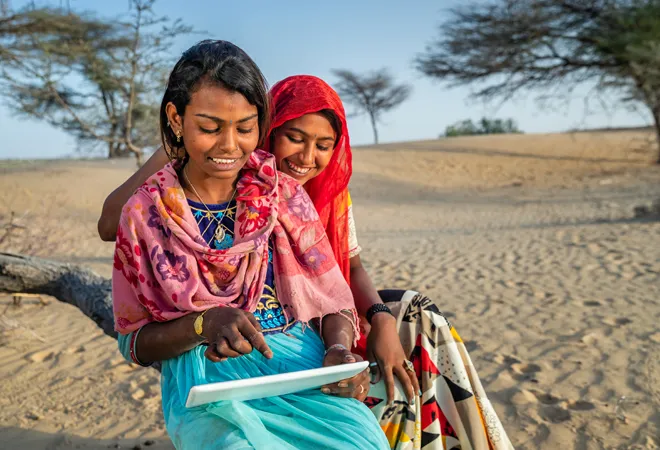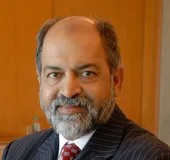-
CENTRES
Progammes & Centres
Location
Digital India today, means different things to different people, but for the world, it means that India with its technology is here to lead

This piece is part of the series, India@75: Aspirations, Ambitions, and Approaches
Saravanan nods with a smile when the payment soundbox tells him the exact transaction amount in Tamil. He sells toys and chocolates outside a school in Tiruchirapalli.
Dhabalesh Majhi raps out of a small house in Kalahandi District in Odisha, using his phone to reach out to lakhs of his followers.
Anurag who has just completed his undergraduate degree intends to help his father in the farms near Bhagalpur. Using digital advisory applications (for planning and pre-planting – IMD forecasts, soil health), Internet of Things (IoT) monitoring devices (in-season care) and digital marketplaces, he helps raise farm revenues—all this using an app via open platform and data sharing.
Vikas requests, processes and gets his MBA loan approval in less than 10 minutes on his phone.
Vidyasagar, a resident of Balkonda Mandal, has been selling his produce through commission agents at Nizamabad market yard for 20 years. He used to stay back in the market yard till weighment completion and wait 20-30 days for payment. Through e-NAM, he sells through direct purchase orders and saves on commission and hamali charges. Furthermore, he gets the payment within minutes online.
Bhanu, along with his classmates, and social media student friends from Assam designed a rooftop rainwater harvesting structure for his locality in Beed, Maharashtra. He posted his success story via a live video on the National Atal Innovation Challenge and got selected within a day. He now gets funding to scale this idea and work with experts in Atal Incubation Centres.
Reena wants to venture into robotics and artificial intelligence. Through Swayam and NPTEL offerings, she curated her personalised course toolkit (rather than a packaged course) to learn what was interesting with live demo sessions. Along with the certification, she managed to interact with experts and meet peers in her cohort with like-minded ideas. She is now ready to tinker and build for India!
More than 70% of Ravi’s crops were destroyed due to untimely rains in Nalanda. He logs onto his mobile app and applies for crop insurance. Through geo-tagged data and satellite imaging, his claims are processed within a day and funds are transferred into his account.
India has more than 750 million internet users today and innumerable small success stories that affect lives—from the kirana store, which has now widened its audience to outside its street, to textile weavers who sell through social media platforms. India is at the cusp of disruptive digital change, one that is already creating the next large businesses, democratising ideas and driving inclusion at a scale never seen before.
India has moved from being the business process outsourcing hub of the ’90s and 2000s—with call centres and software testing—to being at the frontier of innovation and cutting-edge technologies at a population scale.
Today, India is powered by consumption by a burgeoning middle class (70% of total spending) supported by rising disposable incomes and affordable internet penetration (marked by Jio’s entry into the telecom space in 2016) across rural and urban areas. Post liberalisation, India has moved from being the business process outsourcing hub of the ’90s and 2000s—with call centres and software testing—to being at the frontier of innovation and cutting-edge technologies at a population scale.
During the 1990s, India saw a boom in the services sector—predominantly in Information Technology (IT), IT Enabled Services (ITeS), and financial services with the IT industry growing from US $150 million in 1991 to more than $5.7 billion in 2000—which, for the first time, created a new set of Indian-made companies, like Infosys, Wipro, and TCS, have become world beaters riding the 3rd Industrial Revolution Wave. This marked the start of a change in India’s perception of “Electronification and Information Technology’’.
Over the last decade, cyber-computing improvements have steadily narrowed the gap between the real and digital worlds accelerating the onset of Industrial Revolution 4.0 as we know it. India has been a major disruptor in this space taking giant strides in implementing unique, large-scale projects powered by public digital infrastructure.
What is worth noting here is that all such large public digital solutions are built with an open architecture, and are modular with plug and play that essentially seek to democratise and decentralise technology usage. India has been building ‘open digital platforms’, which are tremendous force multipliers (Platformisation). This is critical and unique in being affordable, interoperable, API-driven (and hence scalable), mobile-first in vernacular languages, and allows India’s entrepreneurs to build on the rails of these platforms to innovate and solve problems at scale and for trust.
India today is building cutting edge technology for the world with offerings ranging from social commerce, Software as a Service (SaaS), payments, ed-tech and much more.
India’s start-up landscape has benefited immensely with Aadhaar, UPI, and Jan Dhan (financial inclusion) coming in. The boom in the past five to six years has been phenomenal. Vnture Capital investment surpassed all records in 2021, with more than US $17 billion in funding and 840+ deals. India is home to 81 unicorns with a total valuation of US $275 billion (as on 29 December 2021), 44 of which were born in 2021 itself.
According to MeitY, India’s public and private digital offerings are on their way to unlocking more than US $1 trillion in digital value by 2025. India today is building cutting edge technology for the world with offerings ranging from social commerce, Software as a Service (SaaS), payments, ed-tech and much more.
India’s emerging digital ecosystems supported by robust innovation in start-ups and favourable demographic dividend (with an increase in working age population till 2041 and 3.6 million STEM graduates annually) give us a unique opportunity to lead in the decades to come.
This wave of digital growth would help core digital sectors and ones with immense growth potential (newly digitising logistics, education, healthcare, agriculture) to exponentially increase potential by 2025—financial services (170X) agriculture (70X), education (30X), Government Emarketplace by 25X.
India is already on its way to be the software development engine of the world. This is evident in the fact that it is the fastest growing country in terms of developers contributing on open source, with the number projected to grow to 10 million by 2023. Open-source software development, at the core, solves large-scale issues and democratises technology usage. Indian start-ups have already started exporting software extensively as well (a change from only providing IT services two decades ago); for example, more than 17 million developers and 98% of fortune 500 companies use the ‘Postman API Platform’ today.
Digital forces have started to re-define how we connect and transact with each other and institutions, it has enabled organisations to automate routine tasks to enhance productivity, and it has brought about data-driven decision-making for organisations and governments. Interaction of these forces will carve out new digital ecosystems in the times to come. India stands to gain due to its cutting-edge tech stack.
Indian start-ups have already started exporting software extensively as well (a change from only providing IT services two decades ago); for example, more than 17 million developers and 98% of fortune 500 companies use the ‘Postman API Platform’ today.
India’s Tech Stack backed by a sound foundation (UPI, Aadhaar, open-source architecture with strong data security measures), digital reach (> 1 billion internet users, local language content), can propel India to be the digital factory of the world (software innovation, data analytics).
Digital enablement will drive productivity from MSMEs to big companies, redefine impact in schools and universities (fortifying student skills, increasing Return on Investment and learning outcomes); transform India’s agriculture ecosystem (digital farm advisory, IoT enabled monitoring) to healthcare (demand-supply mismatch – telemedicine, improve quality and trust).
Sectors and industries will radically be impacted and change with digital adoption. For example, software and applications layer would account for 60 percent of the value of an autonomous vehicle in the future (Morgan Stanley). Illustration below:
Leading this digital transformation, the India of tomorrow will drive services and make major strides in manufacturing in the future. (SAMARTH UDYOG Bharat 4.0 aims to create technological solutions at scale and increase the share of manufacturing in GDP to 25 percent by 2025).
Digital India today, means different things to different people—with most being things we take for granted—from ordering food at 2 AM, shopping online, transferring a portion of the salary back home in real-time to creating a reel in the countryside, but what it does mean for the world is that India with its technology is here to lead!
The views expressed above belong to the author(s). ORF research and analyses now available on Telegram! Click here to access our curated content — blogs, longforms and interviews.

Adil Zainulbhai is the Chairman at Capacity Building Commission of India and Quality Council of India.
Read More +